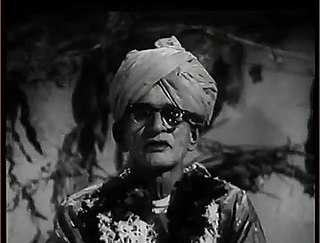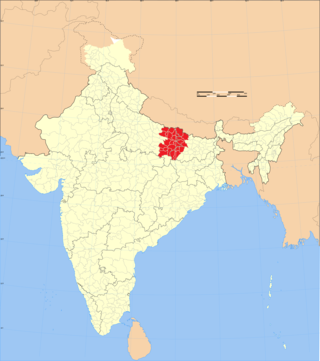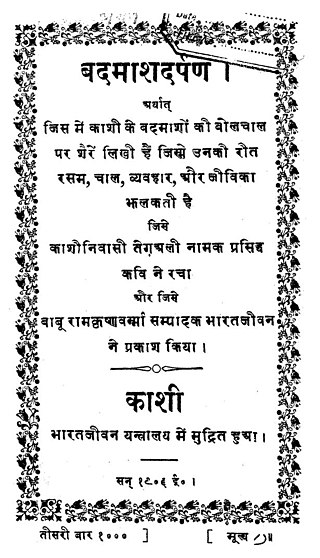
The ghazal is a form of amatory poem or ode, originating in Arabic poetry. Ghazals often deal with topics of spiritual and romantic love and may be understood as a poetic expression of both the pain of loss or separation from the beloved and the beauty of love in spite of that pain.

Bhojpuri is an Indo-Aryan language native to the Bhojpur-Purvanchal region of India and the Terai region of Nepal. It is chiefly spoken in eastern Uttar Pradesh, western Bihar and northwestern Jharkhand. It is an eastern Indo Aryan language and as of 2000 is spoken by about 5% of India's population. Bhojpuri is a descendant of Magadhi Prakrit and is closely related to Maithili, Magahi, Bangla, Odia, Assamese, etc. languages.

Purvanchal is a proposed state in the Bhojpuri region of eastern Uttar Pradesh.

Gopinath Kaviraj was an Indian Sanskrit scholar, Indologist and philosopher. First appointed in 1914 a librarian, he was the Principal of Government Sanskrit College, Varanasi from 1923 to 1937. He was also the editor of the Sarasvati Bhavana Granthamala during that period.

Satya Vrat Shastri was an Indian Sanskrit scholar, writer, grammarian and poet. He wrote three Mahakavyas, three Khandakavyas, one Prabandhakavyas and one Patrakavya and five works in critical writing in Sanskrit. His important works are Ramakirtimahakavyam, Brahattaram Bharatam, Sribodhisattvacharitam, Vaidika Vyakarana, Sarmanyadesah Sutram Vibhati, and "Discovery of Sanskrit Treasures" in seven volumes.

Bhagirath Prasad Tripathi, better known as Vagish Shastri, was an Indian Sanskrit grammarian, linguist, tantra and yogi. In 2018, Government of India awarded him the fourth highest civilian award Padma Shri for his work in the field of literature and education.
Ganga Maiyya Tohe Piyari Chadhaibo is a Bhojpuri film released in 1963 directed by Kundan Kumar. It was the first-ever Bhojpuri film, and starred Kumkum, Ashim Kumar and Nazir Hussain. It had music by Chitragupta, lyrics by Shailendra and songs sung by Lata Mangeshkar and Mohammad Rafi.

Bhikari Thakur was an Indian Bhojpuri language poet, playwright, lyricist, actor, folk dancer, folk singer and social activist. He is widely regarded as one of the greatest writers in the Bhojpuri language and most popular folk writer of Purvanchal and Bihar. Thakur is often called the "Shakespeare of Bhojpuri" and "Rai Bahadur". His works consist of more than a dozen plays, Monologues, poems, and Bhajans, which were printed in nearly three dozen books. His noteworthy works include Bidesiya, Gabarghichor, Beti Bechwa and Bhai Birodh. Gabarghichor is often compared with Bertolt Brecht's play The Caucasian Chalk Circle. Thakur is known as the father of the naach folk theatre tradition. He is also credited as the first person to cast male actors in female roles.

Bhojpur is a ethnolinguistic and cultural area in the Indian subcontinent where the Bhojpuri language is spoken as a mother tongue. The Bhojpuri region encompasses parts of the Indian states of Bihar, Uttar Pradesh, Madhya Pradesh and Jharkhand, and the Madhesh, Gandaki and Lumbini provinces of Nepal.
Bhojpuri literature includes literature written in Bhojpuri language. Bhojpuri has developed over a course of 1300 years, the development of the language started in 7th century. The earliest form of Bhojpuri can be seen in the writings of Siddha Saints and Charyapada. Distinct literary traditions in Bhojpuri language date back to medieval periods when saints and bhakts of the region adapted a mixed language for their works.
Kumar Pradhan was an Indian historian and writer whose research interests include the History of the Eastern Himalayas, Genealogical studies and the Nepali literature. Pradhan has also edited and written a number of literary journals and anthologies and published learned articles in Nepali. He was the chief editor of Sunchari Samachar and other prominent Nepali newspapers.
Balswaroop Raahi is a Hindi poet and lyricist of India. He was born in Village Timarpur New Delhi on 4 May 1936. He is best known for his Geet and Ghazal. He has written many songs for Bollywood. He is a resident of Model Town, New Delhi. He worked as Head of the Hindi department at Delhi University.
Manoranjan Prasad Sinha was a Bhojpuri poet, author and professor and Principal of Rajendra College, Chapra. He is famous for his Bhojpuri poem Firangia, which he wrote in 1921 during Non-cooperation movement. He was also elected as the president of 18th Bihar Hindi Sammelan at Motihari.
Avinash Chandra Vidyarthi was a Bhojpuri author and poet. He was from Shahpur, near Arrah in Bhojpur District of Bihar. He has contributed significantly to Bhojpuri Literature. He was also one of the editors of Bhikhari Thakur Rachnavali, a compilations of Bhikhari Thakur works. His son Prakash Chandra is a physics teacher by occupation and his grandson Ishan Chandra is preparing for NEET. They all live in Patna, Bihar.
Prasiddha Narayan Singh was a Bhojpuri writer, poet, and a freedom fighter. He is known for his patriotic and encouraging poems. Jawaharlal Nehru appreciated his poem Jawahar Swagat on his visit of Ballia during the freedom movement.

Badmash Darpan is a Bhojpuri book written by Teg Ali Teg, which is a collection of Bhojpuri Ghazals. The works are centered about the customs and traditions of Benaras.
Dharani Das (1646-1688) was a Ramanandi saint and Bhojpuri poet who contributed significantly to the development of Bhojpuri literature. He was from a Kayastha family and contemporary of the Emperor Aurangzeb. His followers are called Dharnidasis, who wear a beaded string around the neck, song bhajans and are vegetarian.
Lachhimi Sakhi, also Laxmi Das, Lakshmi Sakhi and Laxmi Sakhi was a Saint and Bhojpuri poet and writer, who is mainly known for his Bhajans and Kajari songs. His real name was Lachhimi Das but since he was a follower of Sakhi sect that's why he is also known as Lachhimi Sakhi. He has written four Bhojpuri books named Amar Pharas, Amar Bilas, Amar Kahani and Amar Sidhi.
Dariya Saheb (1674-1780), also Dariya Sahib, Dariya Das, Daryadas and Bihar Wale was a Saint and Bhojpuri poet and the founder of Dariya or Dariyadasi sect. He has written more than twenty Bhojpuri books out of which Gyan Dipak, and Dariya Sagar are most famous. Gyan Dipak is his brief autobiography.









